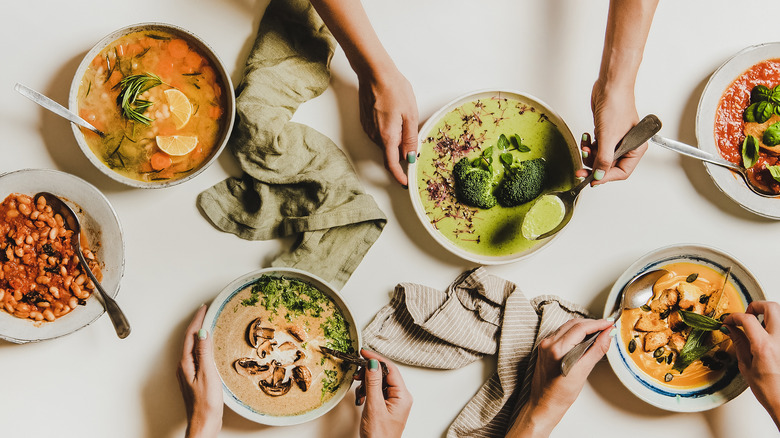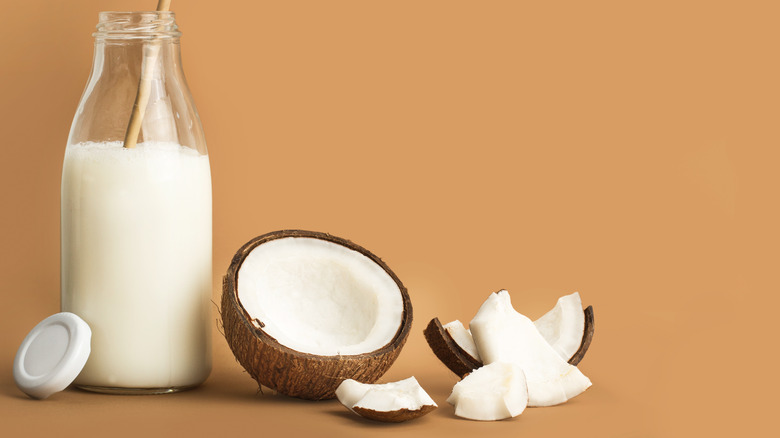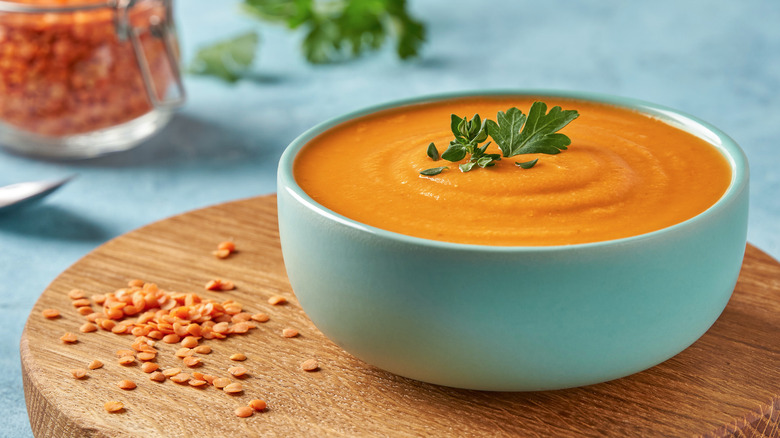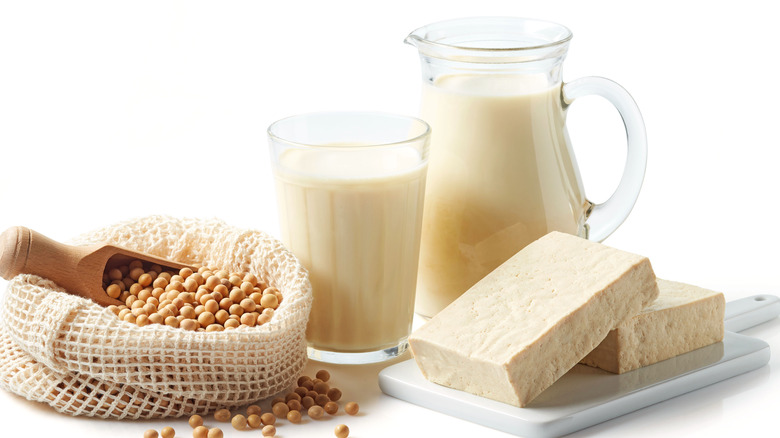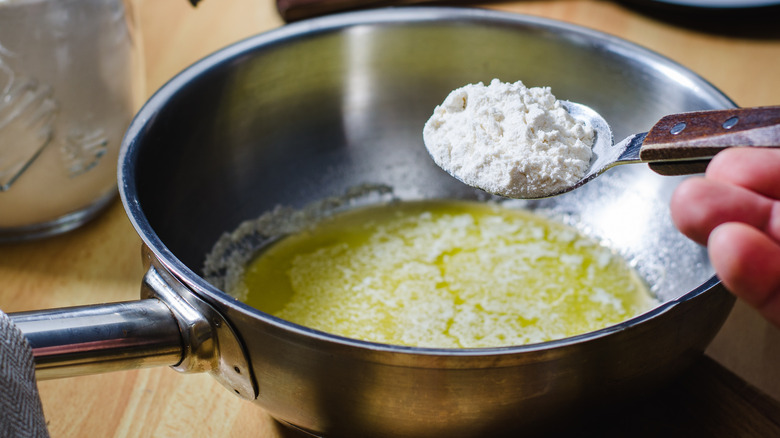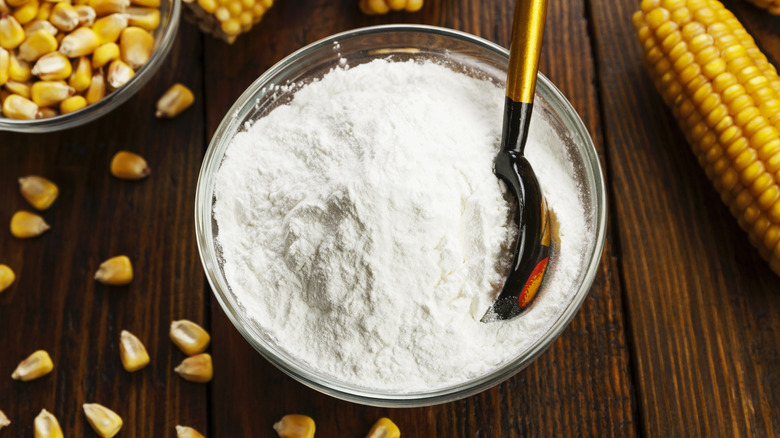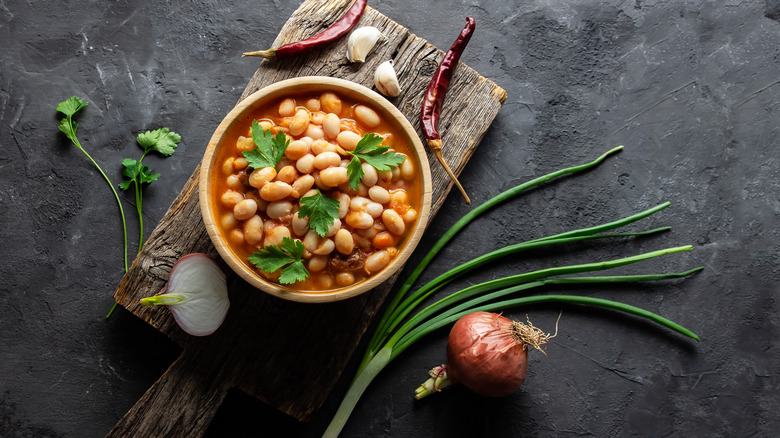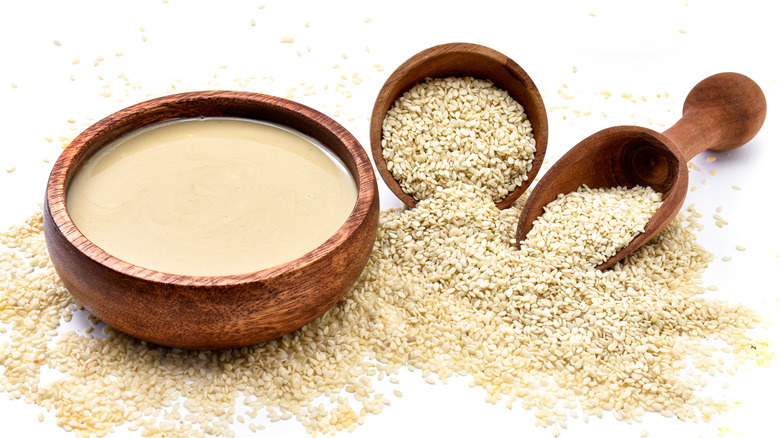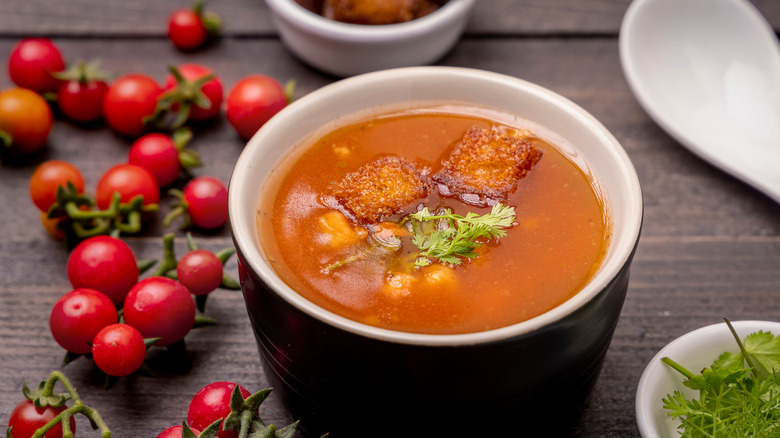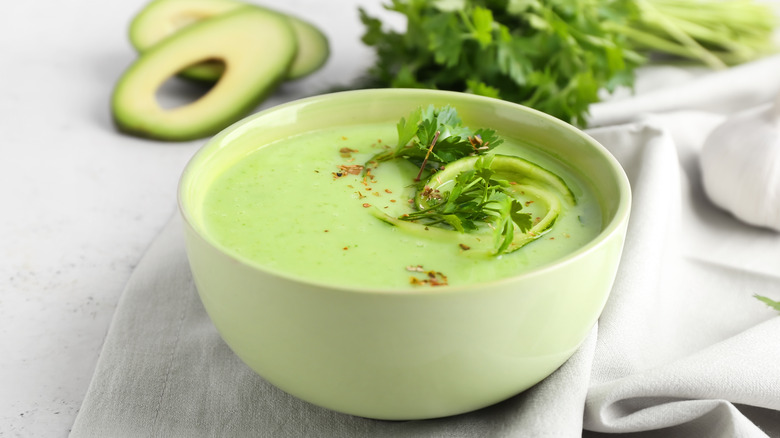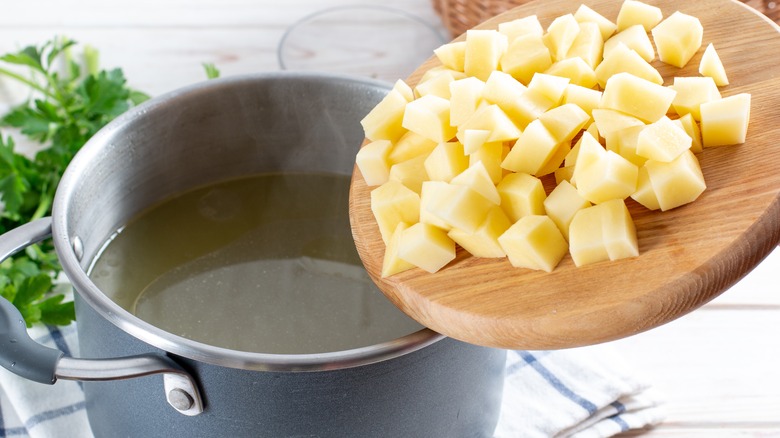11 Clever Tricks To Help Make Creamy Soups Sans Dairy
'Tis the season of "chestnuts roasting on an open fire" and "Jack Frost nipping at your nose." A chill is in the air, and daylight is shorter, making us want to hibernate inside to stay warm and cozy. The perfect comfort food for hibernation is a creamy, warming soup. If you're thinking, "a creamy soup sans dairy? No way!" then these tricks should prove otherwise.
According to the USDA, U.S. milk consumption per capita has trended downward every year for over 70 years. Although dairy is a rich source of protein and calcium, these important nutrients can be found in plant-based foods as well. People are moving away from dairy for a variety of reasons, including health and environmental. Lactose intolerance or a dairy allergy — are negative health reactions to dairy, many people think they are the same thing, but they affect the body differently. Dairy is one of the most common allergies and involves the immune system. The body thinks dairy proteins are dangerous invaders and releases substances to fight them that cause allergy symptom. Lactose intolerance is also common, affecting 30 million Americans, and involves the digestive system. The body doesn't produce lactase; the enzyme needed to digest lactose causes digestive issues.
It can feel like a struggle to replace dairy in our diet since it's found in so many recipes and products, yet surprisingly, you don't need it to make many amazingly smooth dishes, including soup! How, you ask? We'll show you.
Cashews — natures creamiest alternative
Cashew nuts are the greatest non-dairy trick for the creaminess that also packs a healthy punch. They're an excellent source of magnesium and manganese — which help with energy production, brain health, immunity, and bone health. Cashews are also rich in unsaturated fats linked to a lower risk of heart disease. Other benefits include weight loss, improved blood sugar control, and a healthy heart (via Healthline).
You can use cashews to make delectable plant-based cheeses, which can be added to a soup instead of dairy cheese. Another option is grinding the nuts and adding them to a soup to make it thick and velvety. If you don't have a high-speed blender, you can soak them overnight in the fridge or boiled water for 15 to 30 minutes. This will soften them before blending them into thick vegan cheese. Although cashews tend to be the creamiest, any nuts can work. Almonds or almond flour is a great autoimmune-safe alternative for those with health issues, the blog Blue Bird Provisions suggests. Regardless of your choice of nut, they will provide a bit of flavor and texture to thicken the soup. If you don't want a nutty flavor, vegetables like pumpkin, or a cauliflower cashew soup with pomegranate seeds, can offset it.
The power of coconut milk
Coconuts have become increasingly popular for their versatility in the ways you can consume and cook with them. The miraculous coconut can make dairy milk an afterthought. They're also loaded with good nutrients for our health. They provide healthy fats, protein, minerals, and B vitamins. The minerals in coconut are involved in many important bodily functions. For example, manganese supports bone health and the metabolism of carbohydrates, while copper and iron help form red blood cells (via Healthline).
When recipes call for a splash of milk or heavy cream, coconut cream or milk are great substitutes. However, it can affect the flavor, making it too tropical for some recipes. But, if paired with ingredients that marry the flavors like onion, garlic, ginger, or cruciferous vegetables, the coconut taste will balance out. Keeping cans of coconut milk around makes it easy to create an improvised soup when you're in a pinch,
There are a lot of great soup recipes that use coconut milk out there. A vegan roasted tomato soup has the mild sweetness of corn combined with buttery, sweet notes of coconut milk. Many delicious Thai recipes use coconut milk, so try adding this Thai-style butternut squash soup to your dairy-free recipe list! Your taste buds will thank you.
Lentils and chickpeas create a rich texture
The fragrant aroma and robust taste of a curried lentil soup can be a way to connect to the moment and feel comforted, especially with this easy but delicious, easy lentil soup recipe. Lentils and chickpeas (also known as garbanzo beans) are often used to make soups more hearty.
Both are from the legume family, but lentils are small edible seeds, and chickpeas are more similar to a bean. Chickpeas are nutrient-dense, meaning they pack a lot of healthy goodness into a small legume. They're filled with protein, fiber, and complex carbs. Lentils are stout with protein, fiber, and minerals. The pair are quick to cook and are usually very affordable. They can be used whole or blended for soup thickening. If using dried legumes, most should be soaked before cooking. Soaking can cut the cooking time in half, so it's an easy timesaver! There are various techniques and soak times, depending on the type of legume.
The simple yet compelling Moroccan chickpea stew recipe satisfies no need for meat or dairy. Another yummy dairy-free soup is this simple, filling red lentil soup with lemon. If you're looking for some other protein, this shrimp and chickpea soup not only has shrimp but mouth-watering bacon, too. Dairy-free recipes don't need to be complicated or even vegan; these recipes prove that.
Silky tofu blends into a velvet texture
Soft silken tofu is another trick to a creamy soup; easy-to-use and available in most stores. Pureed or blended, it makes a thick consistency close to heavy cream. Tofu — made from soybeans — is a common allergen, so if using it to replace dairy, be mindful (via WebMD). Beyond the flavor, tofu is a great option when looking for a light and silky soup as it's lower in calories, according to Healthline.
Tofu sometimes gets brushed off as bland health food since it absorbs flavors during cooking. But in the right recipe, it can add a depth of texture. Among the tips you need when preparing tofu, keep an eye on which type you choose. There are four main textures: silken, medium, firm, and extra firm. Which one you use will depend on which soup you're making, though silken is most delicate and can liquefy in soups more easily. Tofu is usually submerged in a layer of water that should be drained and, if the recipe calls for it, also pressed.
The following recipes are a good way to add tofu to your cooking. Traditional Japanese miso soup is easy to make with this 30-minute instant pot tofu miso soup recipe. Here, the tofu is served in pieces rather than dissolved into a soup. Korean soups also often use tofu, a spicy favorite is the soft tofu and vegetable soup. It's a healthy and flavorful option if you don't mind a bit of heat.
Whip up a roux
A roux is a traditional thickening agent for soups, stews, and sauces used for hundreds of years in French cuisine (via Michelin Guide). The benefit of a roux is that it thickens while adding a subtle flavor to a dish. It's made from equal parts flour and fat or oil cooked together. The fat sticks to starch granules in flour when cooked, which keeps the roux from lumping and yields a silky-smooth texture when added to a soup.
According to Michelin, butter is traditionally used for the fa. Still, since we're avoiding dairy, you can easily substitute other fats, including oil, lard, rendered fat, or pan drippings from roasted meat. There are four types of roux: white, blond, brown, and dark brown — each resulting from varying cook times. The longer the cooking time, the darker the roux. White or blond roux is most commonly used in soups as it has a lighter flavor. Making your roux takes soups to the next level.
Before making a roux, consider how you'll store it. Roux can be put in an airtight container in the fridge for a few weeks or have it last months by freezing as ice cubes to pop into a future soup.
Prepare a starch slurry
We just discussed the trick of a roux for thickening soup. Similarly, a slurry is another simple technique to achieve this. A slurry is a simple staple for cooking. It's similar yet almost opposite to a roux. A roux is cooked with fat and is added at the beginning of cooking. But, a slurry is uncooked, without fat, and is added at the end of cooking.
To make a slurry, you only need starch and liquid that are whisked until completely combined. There are similarities and differences between flour and starch, but we recommend the latter as the best for a slurry. Consider corn, potato, arrowroot, or potato starch. To make a cornstarch slurry, use a 1:1 ratio, one part cornstarch to two parts liquid (water or broth). If you add unmixed starches to your recipe as a thickening agent, they'll often clump. However, slurring your starch makes it easier to blend in, avoiding the unpleasantness of floating chunks in your soup or stew. Starch slurries are one of the easiest tricks to give your dairy-free soup a thicker feel.
Beans — creaminess, protein, and fiber in one
Beans — the magical fruit — are low in fat, high in fiber, filled with protein, and can add a fair texture (via North Dakota State University). You can add cooked and pureed beans to make a delicious thick soup. When red beans are cooked until tender and mashed, they create a thick consistency that gives body to any soup.
According to Foods Guy, cooking beans release a lot of starchiness, and this bean water can create a creamy texture on the palate without an overpowering flavor. Similarly, cooking beans in your soup will also do a similar thing. To thicken a soup without dairy, you can use canned or beans cooked from dried. If you choose to cook dried beans separately from your soup, use some of the cooking liquid instead of broth or water — it's packed with flavor and creates a thick, smooth texture. Simmering canned or dried beans makes them easy to blend to a smooth consistency in your soup.
Thickening your chili is a classic use for beans, such as in this vegan 3-bean chili recipe. Not a chili fan, but love black beans? A cannellini-broccoli soup recipe uses fibrous foods with tangy dill for a rich flavor combination. This tasty, hearty minestrone recipe calls for any white bean and is also a robust and velvety meal. Or, try a Mexican-style vegetarian tortilla soup chalked full of delectable flavors.
A few spoonfuls of tahini is all you need
Tahini is a sesame seed paste with the smooth consistency of nut butter. But, these days, with more plant-based recipes available, we can see just how versatile it is to use tahini. Tahini has a delicate umami flavor without the sweetness of other nut and seed butter. It may seem surprising, but tahini can be stirred into a soup as a flavor booster and thickener. This ingredient is a shortcut for creamy vegan soup; you only need a spoonful or two to create a velvety texture without overpowering your dish. Tahini is also highly nutritious and rich in antioxidants, anti-inflammatory compounds, and antibacterial properties (via Healthline).
You can easily make tahini at home or purchase it ready-made. If a subtle sesame flavor is undesirable, you can use other nut butter the same way. Nut and seed butter are very adaptable as a thickening agent in recipes and soups, but to choose the right nut butter, consider the flavor palate of your meal. For example, almond butter has a slightly sweet flavor, which can work well for soups with pumpkin, carrot, or coconut.
For a healthy and flavorful soup that uses tahini or sesame paste as a thickener, try to make this vegan miso ramen recipe. The result is a complex flavor full of nutty nuance.
Bread — the simplest thickener
There's a skill required to make even the simplest soup, especially if you're improvising, and sometimes the final product is too watery. If that happens, do like the Italians and add stale or fresh bread to thicken your soup.
You can easily tear up some bread and add it to a boiling broth. Stir consistently so the bread will break down, thickening the soup and creating an almost pudding-like texture that's filling and comforting on wintry days. Some other methods involve placing a slice of bread at the bottom of each serving bowl or simply throwing in pieces of bread as a topper. If you're making a cold soup, adding breadcrumbs or pieces to your blender will do the same. The traditional Tuscan pappa al pomodoro (tomato and bread soup) is a delicious recipe that uses bread as a thickener. Another popular soup using stale bread is gazpacho. Bread gives the vegetable soup a wonderful texture, though since gazpacho is a cold soup, it's better enjoyed during warmer months.
Add avocado or cauliflower
Avocados are popular choices for healthy fats, and not only are they appetizing, but they also encourage fullness (via Medical News Today). Avocados also support healthy skin and nails. They can add a rich flavor and dreamy texture to your soup. It can be as simple as blending one-quarter of an avocado into your soup to bring out these qualities in your recipe.
To make a dairy-free creamy avocado soup, add avocado and other flavorful ingredients in a food processor, and purée to create a velvety texture. You don't need to cook the avocado, or any of the ingredients, since it's a chilled soup. Avocados pair perfectly with most Mexican dishes, and Mexican rice soup is a perfect example. For this soup, you only need to add avocado when serving.
Cauliflower is another crazy versatile ingredient used as a plant-based alternative in many recipes. Cauliflower soup can be incredibly buttery, even without the cheese and cream of traditional recipes. This cauliflower potato soup recipe will satisfy your craving for the classic — minus the dairy — with an option to make it even richer thanks to coconut cream.
Potatoes and yams are handy thickeners
You can have a truly silky soup, even without dairy, with the help of the humble potato. Potatoes can be an unexpected and very effective soup thickener, so if your soup becomes too dense, consider thinning it with extra broth or water. Potatoes can add significant body and creaminess to your soup, even with the addition of just one. Peel your potato if you're not blending the soup. If you're blending it, you can leave it unpeeled. Many types of potatoes are suitable for adding to soups, but starchier varieties will thicken the best.
Another trick to thickening soup with potatoes is to use the tuber in a different form. Pre-mashed potatoes, hash browns, or even potato flakes can all add an extra layer to your soup without the need for dairy.
Soups made with potatoes have a natural creaminess. A truly smooth soup to experiment with is this classic potato leek soup recipe. With the help of the leeks, the blended potatoes make a silken, rich combination. Other delicious pots use sweeter varieties, such as African kale and yam soup, which combine vegetal kale flavors and bright spices with sweeter starch.
